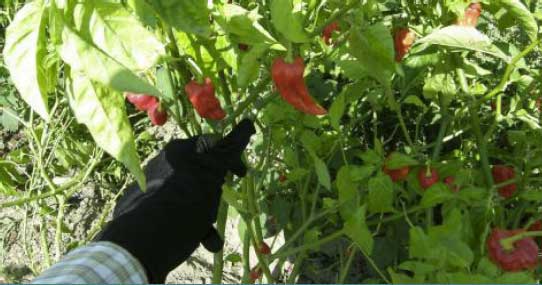Tainan, Taiwan
January 16, 2009
Source:
The
World Vegetable Center Newsletter
Human diets across the world are
heating up, largely due to increasing consumption of chili in
our diet. The
global trend is not only a matter of quantity; worldwide
researchers and consumers are discovering hotter and
hotter chili varieties, with increasing concentrations of
capsaicin. Apart from raising one’s adrenalin level, capsaicin
does not do any lasting damage to the body, and the panting,
sweating, and firey glow is only
temporary. Besides, the more capsaicin a human body is exposed
to, the more tolerance it develops.
In 2007, researchers discovered, tested and validated the
world’s hottest chili: Bhut Jolokia (“ghost chili”). The chili
(Capsicum chinense) was found in northeastern India and in the
neighboring districts of the eastern Himalayan foothills (Assam,
Bangladesh). Its pungency was measured at New Mexico State
University and indicated 1,041,427 Scoville Heat Units (SCU),
which makes it twice as hot as the previous record holder ‘Red
Savina’, a Habanero type chili with 577,000 SCU.
|
 |
|
Not
all of the Center's chili varieties require gloves
as protective measure like this chili variety of
Bhut Jolokia grown on the Center's fields. |
For comparison: The purified
chemical compound capsaicin is rated at 16 million SCU, and
‘weapons grade’ pepper spray is typically around 2 million SCU
hot. The Dorset Naga chili with 1.6 million SCU even turned out
to be a market success in the UK, however one may probably not
have to speculate whether it was for the flavor or the
sensation.
The remarkable spread of the chili (or chilli, or chile, or
chile pepper, to use just a few of its myriad names and
spellings) is a piquant chapter in the story of globalization.
Few other foods have been taken up by so many
people in so many places so quickly. Because the spice
complemented the local foods, it was immediately
adopted and adapted in many regions. It is estimated that one of
four people worldwide (i.e. 1.5 billion
people globally) consume chili on a daily basis.
The Pepper breeding program at AVRDC—The World Vegetable Center
focuses on productivity and yield, disease resistance, and
climatic adaptation rather than on maximizing the capsaicin
content of chili varieties. “We nevertheless continue to include
selections that are considered quite spicy in lines released to
the public. Seed of a line related to Bhut Jolokia was
contributed by New Mexico State University and is currently
being multiplied in field increase plantings”, says Dr. Paul
Gniffke, the Center’s leading pepper breeder.
Other famous hot varieties (e.g. ‘Red Savina’, and ‘Guam
SuperHot’) are also included in AVRDC’s Capsicum
seed collection, which numbers more than 7,500 accessions.
Source: Dr. Madhusudan Bhattarai, Dr. Paul Gniffke |
|